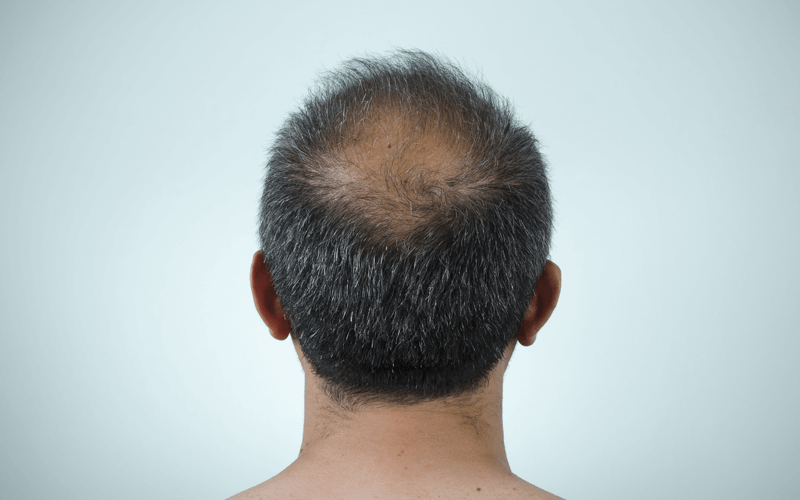
Androgenetic alopecia, also known as male pattern baldness, is the most common cause of hair loss in men, accounting for over 90% of male hair loss. Around 25% of men begin seeing symptoms of male pattern baldness as early as their twenties.
Male pattern baldness can lead to frustration, feelings of self-consciousness, social isolation and even depression. Is your hair falling out? How do you know if your thinning or receding hair is a result of male pattern baldness?
What Is Male Pattern Baldness?
Male pattern baldness is characterized by a pattern of receding or thinnning hair at the front of the hairline, the temples and the crown. The condition progresses until partial baldness occurs and just a rim of hair remains. For some men, male pattern baldness eventually leads to total baldness.
Male pattern baldness is generally triggered by the male hormone dihydrotestosterone (DHT), a byproduct of testosterone. These hormones are important to male sexual development and regulate things like sex drive and hair growth.
Genetically, some men’s hair follicles are sensitive to DHT, and for these individuals, continued exposure ultimately causes the follicles to shrink and stop producing hair normally. The areas of the scalp most sensitive to DHT — the temples and crown — are generally the most prominently affected. With early enough intervention, DHT exposure to the hair follicle can be slowed or even stopped.
A diagnosis of male pattern baldness is usually determined by a physician or medical hair loss expert and includes an assessment of your overall hair loss pattern, an examination of your scalp and a complete medical history including questions about hair loss in your family.
Androgenetic alopecia, on the other hand, affects both men and women. It is the leading cause of female hair loss, affecting millions of women around the world. Women, in fact, make up 40% of hair loss sufferers worldwide.
The Norwood Scale
The Norwood Scale is used to measure how far male pattern baldness has progressed:
Stage 1: The baseline of the scale indicates no hair loss.
Stage 2: This stage begins with minor recession at the front of the hairline and some recession at the temples. Individuals at this stage may not have considerable hair loss. Stage 2A is reached when the recession has progressed across the entire frontal hairline.
Stage 3: At this stage, hair recession at the temples begins to deepen. During Stage 3A, frontal recession also deepens, with the hairline continuing to move backwards. Stage 3V occurs when there is also evident hair loss on the crown.
Stage 4: During Stage 4, frontal and temporal hair loss progresses, and the bald patch at the crown enlarges. At Stage 4A, the hair loss progresses past the mid-crown.
Stage 5: At this stage, the bald area in front enlarges and starts to join the bald area at the crown.
Stage 6: During this stage, the bald area in front and the bald area at the crown fuse and continue to enlarge. The back part of the bald area is wider than it was during Stage 5.
Stage 7: The final stage is extensive baldness with only a strip of hair remaining at the back and sides of the scalp.
Treatments for Male Pattern Baldness
Medical advancements have made it possible to slow or stop the progression of hair loss for some men, but successful treatment is largely dependent on early intervention. It is important to contact your doctor as soon as you notice hair loss.
In 1997, the FDA approved Finasteride, the generic name for Propecia, to treat male pattern baldness. The drug, which was originally developed to treat enlarged prostate glands, inhibits Type II 5-alpha-reductace, the enzyme that converts testosterone into DHT. If taken daily, Propecia can lower DHT levels by as much as 60%. Lowering DHT has been shown to stop the progression of hair loss.
Minoxidil (loniten) was the first FDA-approved drug to treat male pattern baldness. Originally prescribed as a high blood pressure medication, minoxidil effectively regrows hair when applied topically to the scalp.
Though minoxidil has proven to slow the progression of hair loss and has the ability to regrow some hair, it has no effect on the hormonal process of hair loss. As a result, the effects are generally temporary.
Hair restoration technology has also greatly advanced in the past few years. Revolutionary non-surgical treatment options are now available to replace lost hair with long-lasting, natural-looking results.
Are you suffering from male pattern baldness? A certified NeoGraft physician in your area can help you to understand all of the non-invasive hair restoration solutions available to regrow your lost hair. Contact Dallas NeoGraft today and take the first step to restoring your hair and your self-confidence.



